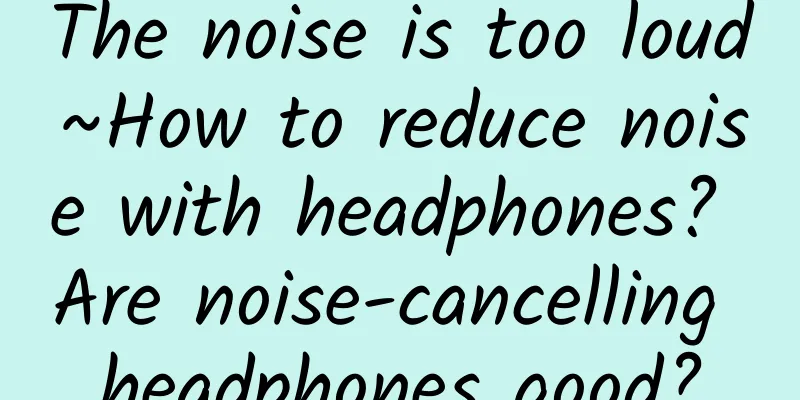The noise is too loud~How to reduce noise with headphones? Are noise-cancelling headphones good?

|
The symphony of the city is not always pleasant to the ears. At 6:30, the alarm clock broke the silence. At 7:00, the roar of the subway, the advertisements on the platform, and the conversations of the passengers constitute an urban symphony without a conductor. 7:40, on the road downstairs from the company, the sound of car engines, the friction of tires, and the noise from the construction site are all testing our auditory nerves. At 8:00, in the office, the ringing of telephones, the sound of conversations, and the sounds of keyboards intertwined into an office serenade without pauses. Image source: soogif When we were young, we were surrounded by the sounds of nature, such as running water, birdsong and insects. But now, these sounds have been replaced by the hustle and bustle of the city. Fortunately, the emergence of noise-canceling headphones has helped us have the opportunity to escape from the noise for a short time. Image source: Pixabay 01How do noise-cancelling headphones achieve noise reduction? Before exploring the secrets of noise-canceling headphones, let us first distinguish between two types of noise reduction: passive noise reduction and active noise reduction. Passive Noise Reduction: The Art of Physical Isolation In short, it is to block external noise through physical isolation. This method relies on the design of the headphones, which fit the ears tightly through earmuffs or earplugs, and then use special sound-absorbing materials to enhance the tightness. It is like covering your ears with your hands to block out the noise from the outside world. Passive noise reduction is more effective for high-frequency noise and is relatively low-cost, making it a common noise reduction method on the market. However, in order to achieve better sound insulation, headphones often require a more compact headband design or a larger cavity to fill the ear canal, which may come at the expense of our wearing comfort. Active noise cancellation: the magic of technology The emergence of active noise reduction technology has found a balance between comfort and noise reduction effect. Its principle can be described in three simple steps: Capturing ambient noise: First, the microphone on the headset detects and captures the noise sound waves in the environment, which we call sound waves (A). Generation of reverse sound waves: Next, the intelligent system inside the earphones quickly calculates the opposite sound wave of sound wave A, which is sound wave (-A). Fusion and playback: Finally, combine this reverse sound wave (-A) with the music sound wave (B) you want to listen to to form a new fusion waveform (-AB) and play it. In this way, the original external noise sound wave (A) is neutralized by the reverse sound wave (-A), and your ears are left with only the relatively pure music sound wave (B). It's like using "positive power" to dissolve "negative interference". Active noise-cancelling headphones use the "magic" of technology to bring us a quiet listening space. The principle seems simple, but it took nearly 100 years from the time when British physicist John William Strat, third Baron Rayleigh, proposed the concept in 1878 until 1986 when the American company BOSE launched the first noise-cancelling headphones for pilots to try. The technical difficulty lies mainly in the second step. On the one hand, the noise received by active noise reduction headphones is not a single sound wave, but unpredictable sound waves coming from all directions; on the other hand, the digital signal processor needs to process, invert, and play these unpredictable data in a very short time, and these processes need to be completed within one millionth of a second. 02How is it different from the principle of noise-canceling earplugs? What is the difference between active noise reduction headphones and noise-canceling earplugs? As mentioned above, the core of active noise reduction headphones is to neutralize noise by generating sound waves with equal amplitude and opposite phase to the external noise. The principle of noise-canceling earplugs is mainly physical isolation. Image source: Pixabay Compared with passive noise reduction earplugs, which rely heavily on the sound insulation effect of physical sound insulation materials, active noise reduction is not only better in noise reduction effect, but also better protects hearing. Of course, the price is also relatively high. 03Are noise-canceling headphones ear-friendly? In the past, even if you wore traditional headphones in a noisy environment, you would still be bothered by the external ambient noise. In order to hear the music or audio clearly, users often turned up the volume to exceed the safe level (80 decibels), which greatly increased the risk of hearing damage. Active noise reduction headphones can reduce or isolate environmental noise, allowing users to enjoy clear sound quality at low volume, thus providing a quieter ear canal environment. Therefore, they have a certain protective effect on hearing. Image source: Pixabay However, using noise-canceling headphones for an extended period of time may still have a certain impact on hearing. Many people should have this experience: after wearing noise-canceling headphones for a long time, you will find that the surrounding sounds become unusually clear and loud when you take them off. This is because after being in a low-noise state for a long time, the ears mistakenly think that you are "deaf" and therefore cannot hear the sound, and the receptors will increase the sensitivity and responsiveness of the hearing to compensate for the situation of "not being able to hear" the sound. This increased sensitivity makes the ears react more strongly to high-noise environments, and may even cause auditory fatigue or other discomfort symptoms. In addition, wearing noise-canceling headphones for a long time will compress and block the ear canal. First, the closed and moist ear canal environment is conducive to the growth of bacteria. Second, long-term squeezing can easily cause damage to the external auditory canal, allowing bacteria to enter and cause infection, increasing the probability of external otitis. 04 Daily ear protection tips 1. Headphone usage time: It is recommended not to wear headphones for more than 60 minutes continuously per day, and the volume should be controlled within 60% of the maximum volume to reduce potential damage to hearing. 2. Dealing with noisy environments: In noisy environments, it is recommended to use earplugs or noise-canceling headphones to avoid having to increase the volume to high decibel levels that are harmful to hearing. Image source: Pixabay 3. Rest your ears: Give your ears a break regularly. Try not using your headphones occasionally, or use hands-free mode when answering a call to give your ears some valuable rest time. 4. Ear care: After bathing or swimming, wipe your ears with a clean towel in time to keep the ear canal dry to reduce the risk of moisture breeding bacteria and infection. Avoid using cotton swabs to dig deep into your ears to prevent earwax from being pushed deep into the ear canal or damaging the eardrum. Clean earwax moderately to avoid ear canal problems caused by excessive cleaning. 5. Healthy lifestyle: Actively engage in aerobic exercise, such as brisk walking, running, or participate in soothing activities such as yoga and meditation, which can help promote blood circulation and have a positive effect on hearing. At the same time, supplement vitamins, quit smoking and avoid junk food to reduce the negative effects of nicotine, carbon monoxide and bad cholesterol on blood vessels and hearing. Source: Chongqing Science and Technology Museum Author: Wei Yi, PhD of Chongqing Medical University, one of the top ten science popularization ambassadors in China Review experts: Huang He, Li Chunli, Xu Xiaoping Statement: Except for original content and special notes, some pictures are from the Internet. They are not for commercial purposes and are only used as popular science materials. The copyright belongs to the original authors. If there is any infringement, please contact us to delete them. |
<<: Looks like a little "towboy", but it turns out to be a Devonian coral
>>: “Xiangshou Crab” has become a hot topic. Are pet crabs going to become internet celebrities?
Recommend
Spring is the right time to lose weight, but how can you effectively reduce excess fat in your body?
With the end of winter, many people are planning ...
23 common senses you must know when operating a public account!
1) About choosing a subscription account or a ser...
Designed in the late 1950s, the Blackbird is an absolute miracle in aviation history.
© National Air and Space Museum Leviathan Press: ...
How much does it cost to customize the Lhasa teaching materials applet? What is the price quote for customizing the Lhasa teaching materials mini program?
The mini program provides convenience for publici...
New strategy for promoting brands on Xiaohongshu!
Double Eleven is coming soon. According to the la...
Facebook user growth strategy!
Whenever we talk about growth, we have to mention...
Please note when you see this: Don’t cross your legs!
In the previous article when I was explaining cer...
South Korean Prime Minister: Bitcoin harms young people and makes them fall into pyramid schemes or drugs
Beijing time, November 28 afternoon news, South K...
5 formulas you must master to operate e-commerce well
With the rapid development of e-commerce, more an...
Ditch the PC? Why did you spend $14,000 on a new MacBook Pro?
The professional-oriented MacBook Pro received it...
Can water be compressed?
About 70% of the earth's surface is covered b...
Will television really die under the influence of mobile Internet?
In this era of rapid development of mobile Intern...
The bridge deck of a highway in Hubei overturned. From a professional perspective, here is a guide: Are single-column pier bridges safe?
At about 3:36 pm on December 18, a rollover accid...
Chinese home appliances are transforming, while Japanese companies are changing their ways
In recent years, while Chinese home appliance com...









